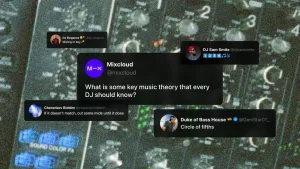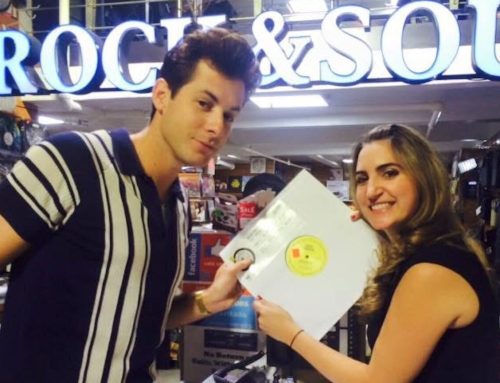
Learning music theory is a good step towards understanding the music you play in your DJ sets. Here are a few topics to get you started.
When you start DJing, you’re probably excited by the simple fact that you’re able to play your favorite tunes and blend them together in interesting ways. As you continue DJing, you start to learn a lot more about how the music itself works and how it’s composed. Music theory is the backbone of music itself. It explains why sounds are the way they are and the dynamics that go into a track, note or chord.
If you look at songs, mixes or albums that you’re a fan of, you’ll see thousands of elements. Learning music theory can go a long way in improving your musical education. Especially once you start applying it to your DJ sets to take them to a new level of creativity.
But which pieces of music theory should you be digging into? Where do you start when you want to train your musical brain? Well, we put the call out to our Mixcloud community for the answers. Here are just a few pieces of music theory that you can take with you into your next mix.
Pitch and rhythm
Two of the many things that lie at the heart of anything musical are pitch and rhythm. They help you keep your DJ set in a good flow and energy. You can recognize patterns that can blend together well when you’re picking a track to blend into. If you want to mix two tunes together on your decks, you need to adjust the speed of the track to fit the other. To do this, you adjust the pitch.
Pitch
Simply put, pitch relates to how high or low a sound is and its frequency. Each pitch has a different frequency, which is what makes it sound high or low or somewhere in between. For example, have you ever noticed when you tap a glass in certain areas that the sounds are different? One sound you make might be high-pitched, but a tap in another place might emit a lower sound? This is pitch in full display, with any single part equalling a different frequency.
Different instruments also give off different types of pitch. A woodwind instrument like an oboe is likely to have high levels. Meanwhile, a string instrument like a double bass is traditionally low in pitch. Meanwhile, guitars and pianos can be played at both high and low pitches. In a DJ set, you can adjust the pitch of tracks at your will. You can use faders on your CDJs to control the speed of the song you’re playing. Thus, creating all kinds of opportunities for your blends.
Rhythm
Meanwhile, rhythm is the pattern of sounds, silences and emphasis that creates a sense of movement, pulse, and groove in a song. It’s the arrangement of notes and rests in time, and it tells you when notes are played, how long they are played, and with what intensity. Rhythm is at play with every song you can think of, and more, but in increasingly different ways. A Techno song, for example, is rhythmically constructed differently to a Rock song. It will have different silences and emphasis on chords, keys and other notes. With an understanding of rhythm, you’ll be able to better find out which tunes work best for you when you’re looking for new music for your set.
Time signatures
In music, a time signature is how the rhythmic pattern of your music is characterised. It’s made up of bars, which are groups of beats. A time signature will indicate how many beats there are to a bar so the 4/4 time signature (widely used in dance music) is made up of 4 beats to a bar, meaning each quarter note gets one beat. Think of The Bee Gees’ classic ‘Stayin’ Alive’ and its pulsing rhythm; each snare counts as a bar with four beats. A bar can have different note durations, as long as the total duration remains four beats. For example, a bar could have one whole note, two half notes, or a half note with two quarter notes, any mixture of half and quarter notes.
Sometimes, tracks will have eight-bar loops. These are sections of music that run eight measures long, sometimes referred to as ‘phrases’. Essentially, these are loops of your main melody. An example of a famous track that runs on an eight-bar loop is Elvis Presley’s ‘Heartbreak Hotel.’ Typically with these, your musical arrangement will change in some way after every eight bars. It could be a new synth, a different snare, hi-hats or a new drum pattern. Ultimately, time signatures help you understand how to count music. That way, you can drop the beat of your next track at the perfect time, get them playing in sync and seamlessly mix from one to the other.
The circle of fifths
Now you know about pitch, rhythm and bars, let’s get into musical keys. These tell you which sounds go well together and which clash. They’re divided into major and minor keys, which all revolve around 12 musical notes, ranging from A to G and the major and minor versions of these notes. For example, B major will sound different to B minor, and so on. That’s a total of 24 keys that your music can live and develop within.
If you want to get an idea of all major and minor keys and how they work, the circle of fifths is a great guide. It’s a visual wheel showing where all notes in major and minor sit. Major keys are on the outer circle and their minor keys are in the inner circle. Each letter in the circle can be either a chord or a note. The circle of fifths does a great job of assigning musical keys to their accompanying note. So, if you’re a DJ, you’ll have a greater understanding of what can be mixed with what, according to their key. The best part? You don’t have to remember each of these keys; music experts have already laid the groundwork. Which leads us to…
The camelot wheel
Where the circle of fifths visualizes every musical key, the camelot wheel goes a little deeper. It shows you every minor and major chord, with a number and letter combination showing all 24 minor and major keys. From 1A to 12A and 1B to 12B. Like the circle of fifths, it tells you which musical keys sound best together. Once you know what the key of a song you want to play is, refer to the camelot wheel to work out which other keys work with it. Or take it a step further and guide the story your mix tells by shifting from a major to minor key or vice versa. This will make the tracks in your mix mix sing from the same hymnsheet, so to speak!
The wheel was designed specifically for DJs to get to grips with keys and chords. To understand how melodic and harmonic tunes can be blended together effectively. So, this is a great resource to go to if you want to learn. Or, to go back to if you want to sharpen your knowledge. You can use the wheel to inform how you put your mixes together. Or even to organize your playlists by key, without having to spend much time memorizing the circle of fifths.
Harmonic mixing
Once you have a basic understanding of keys, you can apply harmonic mixing to your DJ sets. Harmonic mixing involves making sure that the keys of the tracks you blend are harmonically compatible. In other words, in the exact same key. This allows your mixes between tunes and your overall set to be a lot smoother, because your transitions will have the foundation of being musically aligned with each other. Elements like notes, chords and melodies of each following track will work together. This can apply to whether you specialize in one genre in your sets or prefer an open format.
If you master harmonic mixing, you’re able to really determine the vibe of your mix from a musical and theoretical standpoint. Let’s say you arrange your tunes in your library by key; you have a ready made list of tracks to get into and play. It’s a fairly advanced technique, because you have to be aware of the key of every track you play, which may take some time. Mainly because you’ll have to train your ear to detect different keys. But this can be accomplished using DJ software like Serato, Rekordbox and Virtual DJ. Making use of the circle of fifths and camelot wheel can help paint a picture of where keys lie and how they talk to each other. You can apply both to your learning if you choose to use software to get to grips with harmonic mixing.
Time to get stuck in!
There’s so much out there to get to grips with when it comes to music theory. Probably too much to fit into one article, but the topics listed above can serve as a starting point to help you along your DJ journey. The key is to embrace everything; it might seem like a lot to learn at first but, step by step, you’ll feel a great accomplishment. And have mixes that flow better and better each time!





Leave A Comment
You must be logged in to post a comment.